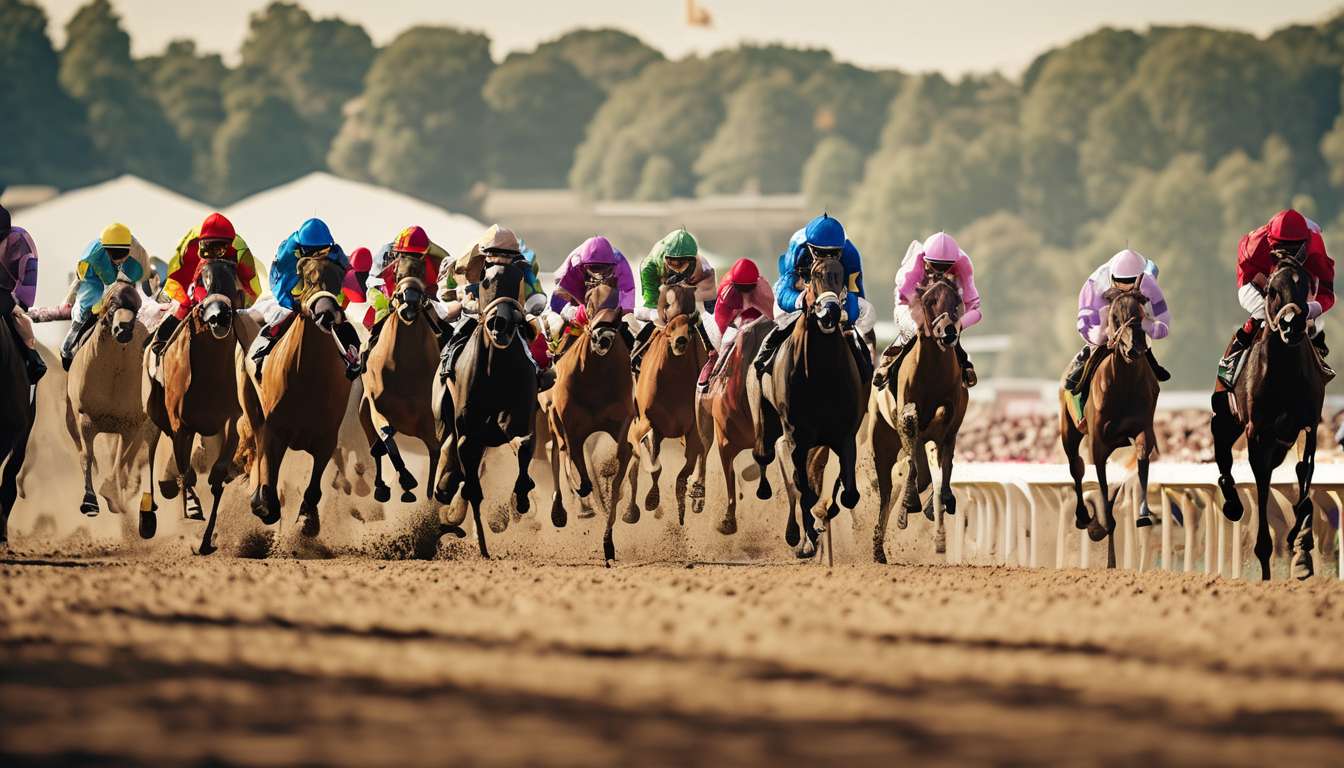In the thrilling world of horse racing, understanding the nuances between morning line odds and actual race odds can be the key to making informed betting decisions.
As avid racing enthusiasts, we often find ourselves pondering the significance of these numbers and how they can impact our wagering strategies. In this article, we will explore the top seven ways to effectively compare morning line odds with the odds available closer to race time.
1. How Morning Line Odds Are Set:
- Morning line odds are set by track handicappers.
- They serve as a predictor for the initial betting market.
2. Factors Influencing Odds Shifts:
- Late-breaking news.
- Weather conditions.
- Insider insights.
By delving into these factors, we aim to equip ourselves with the knowledge to harness these odds to our advantage, ultimately enhancing our overall racing experience.
Analyzing Market Trends
Morning Line Odds
Morning line odds are set by track handicappers and provide an initial glimpse into how a race might unfold. These odds incorporate various elements, giving us a foundation to start our analysis:
- Track bias
- Trainer intentions
Actual Betting Odds
The actual betting odds tell a dynamic story about market sentiment and collective wisdom as they evolve. Analyzing these odds involves understanding several factors:
-
Bettor Insights: Reflect the hive mind of bettors who assess:
- Track conditions
- Strategic moves of trainers
-
Trainer Intentions:
- Can significantly shift odds
- React to changes in preparation or strategy
By understanding these elements, we deepen our connection to the vibrant community of horse racing and enhance our ability to predict outcomes successfully. This comprehensive approach allows enthusiasts to tap into both the quantitative and qualitative aspects of horse racing, leading to more informed decisions.
Evaluating Track Bias
In our pursuit of understanding race outcomes, evaluating track bias is crucial as it directly impacts how horses perform on different surfaces. Recognizing track bias helps us better predict which horses might have the upper hand.
When considering the morning line, it’s essential to factor in how track conditions can sway results. A track that favors speed or closers can significantly alter how we interpret morning line odds.
We must also consider trainer intentions in this evaluation. Trainers often tailor their strategies based on expected track conditions, aiming to align their horses’ strengths with the prevailing bias. By understanding these intentions, we gain insights into possible shifts in performance that may not be immediately obvious.
Together, as a community of enthusiasts, our shared knowledge of track bias enriches our experience and understanding. By pooling our insights, we can more confidently:
- Assess morning line figures
- Make informed decisions at the races
Understanding Late Money
Late Money and Sharp Bettors’ Insights
Late money often reveals the insights of sharp bettors and can dramatically influence final odds. As we gather at the track, we notice how the morning line odds start shifting as race time approaches.
This shift often indicates where seasoned bettors are placing their bets, potentially revealing insider knowledge. By observing these changes, we can infer if certain horses have caught the eye of those in the know, possibly due to hidden factors such as:
- Track bias
- Subtle trainer intentions
Interpreting Odds Shortening
When we see a horse’s odds shortening close to post time, it might be due to:
- A last-minute tip-off
- A strategic move based on the day’s conditions
We should pay attention to these fluctuations, as they might signal a consensus among sharp bettors who have assessed the morning line and found discrepancies.
Connecting with the Racing Community
Understanding these late movements helps us feel connected to the racing community. We share in the collective wisdom and excitement that only comes with being part of the action.
Factoring in Jockey Changes
Jockey changes can significantly impact a horse’s performance, and it’s important to consider these adjustments when evaluating pre-race odds.
The morning line might not fully account for a new rider’s skill or experience, which can lead to discrepancies between these odds and the actual betting odds.
Key Considerations:
- When a top jockey is replaced or a less experienced rider is brought in, it could indicate:
- A strategy shift influenced by track bias
- An adaptation to the horse’s unique needs
By understanding these nuances, we become more connected to the race dynamics.
Trainer Intentions:
- Trainer intentions often align with jockey changes, suggesting:
- A calculated plan to enhance performance
- An opportunity to capitalize on specific track conditions
In our community, sharing insights like these helps us all grow. This exchange ensures we make informed decisions based on the details the morning line might overlook.
By staying alert to these subtle signals, fellow enthusiasts can find an edge in the competitive world of horse racing.
Scrutinizing Trainer Intentions
We should closely examine how trainers’ strategies and decisions influence a horse’s performance and betting odds. Trainer intentions can significantly sway the morning line and final odds, providing insight into a horse’s potential success.
As a community of racing enthusiasts, understanding a trainer’s past successes, training regimen, and race placement choices can offer a competitive edge.
When evaluating morning lines, we need to:
- Account for track bias.
- Understand how trainers tailor their strategies to exploit this bias.
Trainers often select races where a horse’s strengths align with the track conditions, shaping both performance expectations and betting odds. Recognizing these subtle maneuvers can enhance our understanding of the race dynamics.
Let’s not overlook trainers with a knack for surprising wins, as their intentions might not always align with public perception. By scrutinizing trainer intentions, we can better interpret the morning line and adjust our bets accordingly.
Together, this shared knowledge deepens our connection and enjoyment of the racing experience.
Considering Recent Form
Evaluating a horse’s recent performance history gives us crucial insights into its current fitness and potential race outcomes. A horse’s latest races can reveal its readiness and how it might handle the upcoming competition.
When comparing morning line odds, it’s essential to factor in recent form. A horse with a strong track record in its last few races might be undervalued in the morning line, presenting a betting opportunity.
As members of a community passionate about horse racing, we understand that track bias can significantly influence recent performances. If a horse has been racing on tracks that suit its running style, it might have an edge that isn’t reflected in the morning line odds.
Additionally, understanding trainer intentions can be insightful. Trainers might:
- Choose specific races to build a horse’s confidence
- Target a particular event, affecting recent form
Let’s use these insights to make informed decisions on race day.
Comparing Public Perception
Public Perception and Betting Odds
Public perception often influences betting odds, creating opportunities to find value if we look beyond popular opinions. When discrepancies arise between the morning line and current odds, it is crucial to investigate further.
Factors Influencing Odds Shifts
- Bettors’ actions, influenced by:
- Track bias
- Favorite trainer’s intentions
By understanding these elements, we can make informed decisions that aren’t solely based on public sentiment.
Exploring Track Bias
Track bias can significantly impact how odds fluctuate. Sometimes, bettors overreact to a perceived bias, causing odds to skew. By remaining objective, we can identify when a horse might be undervalued.
Understanding Trainer Intentions
Understanding trainer intentions is also crucial. If a trainer has a specific strategy in mind, it might not align with the crowd’s view, presenting a hidden opportunity for us.
Leveraging Insights for Better Bets
Together, we can leverage our insights into morning lines and odds, ensuring we’re united in making smarter, more rewarding bets.
Using Historical Data
Analyzing historical data allows us to identify patterns and trends that can enhance our betting strategies. By examining past performances and outcomes, we can better understand how morning line odds stack up against the actual odds on race day. This insight helps us feel more connected to the racing community as we become more informed participants.
Track bias is another important factor to consider, as it influences race results. Different tracks favor certain running styles, and knowing this can give us an edge. Historical data can reveal:
- Which tracks have biases
- How these biases affect morning line odds
This understanding strengthens our sense of belonging among fellow racing enthusiasts.
Trainer intentions also play a crucial role. By studying past races, we can spot trainers who consistently outperform the morning line odds, indicating strategic intentions. Recognizing these patterns allows us to anticipate future performances.
Together, by leveraging historical data, we become part of a knowledgeable group, enhancing our betting strategies and race day experiences.
How do morning line odds affect the betting pool size and distribution?
Morning line odds play a crucial role in shaping the betting pool size and distribution.
They serve as a starting point for bettors to gauge a horse’s perceived chances of winning, influencing where they place their bets.
When morning line odds are significantly different from the actual odds at race time, it can lead to shifts in the betting pool, affecting the payouts for winning bets.
This dynamic interaction keeps the betting experience engaging and unpredictable.
What is the role of a morning line oddsmaker, and how do they formulate their predictions?
As oddsmakers, our primary responsibility is to craft morning line predictions that forecast how the public will bet on a race.
This involves several key tasks:
-
Analyzing Past Performances: We examine each horse’s previous races to assess form, speed, and consistency.
-
Evaluating Track Conditions: Understanding whether the track is fast, muddy, or anything in between is crucial for accurate odds.
-
Considering Other Factors: This includes jockey performance, trainer statistics, and any recent changes in horse health or training.
By setting initial odds, we provide a baseline for bettors to consider before the race starts. Our goal is to create a fair and accurate representation of each horse’s chances, thus helping bettors make informed decisions.
Ultimately, our work supports a balanced and engaging betting environment.
Are there any common misconceptions about morning line odds among novice bettors?
Understanding Morning Line Odds
Sometimes, novice bettors misunderstand morning line odds.
They may think these predictions guarantee the actual odds, but they’re just a starting point.
Another misconception is that morning line odds reflect the true probability of a horse winning. In reality, they are influenced by public perception.
Key Points for New Bettors:
-
Morning Line Odds as a Starting Point:
- These odds are not final and will change as betting progresses.
-
Influence of Public Perception:
- Odds are set based on how bettors might wager, not on the true chance of winning.
Importance for New Bettors:
It’s crucial for new bettors to grasp these nuances to make informed decisions and improve their betting strategies. Understanding the role and nature of morning line odds can significantly enhance their approach to betting.
Conclusion
When comparing morning line odds to actual odds, it’s important to stay informed on several key factors:
-
Market Trends: Understanding how the betting market shifts can provide insights into public and expert sentiment.
-
Track Bias: Some tracks favor certain running styles or positions, which can influence outcomes.
-
Late Money: Pay attention to bets placed just before the race, as these can indicate insider knowledge.
-
Jockey Changes: A switch in jockeys can signal strategic moves from trainers.
-
Trainer Intentions: Be aware of a trainer’s plans and strategies, which can be gleaned from interviews and past behavior.
-
Recent Form: Evaluate how a horse has performed in recent races to gauge its current condition.
-
Public Perception: Understand how public opinion affects odds, which might create value betting opportunities.
-
Historical Data: Analyze past performance data for patterns and trends.
By utilizing these factors, you can make more informed decisions when betting on horse races. Keep a keen eye on all these aspects to improve your chances of picking winners and maximizing your profits at the track.
Happy handicapping!




